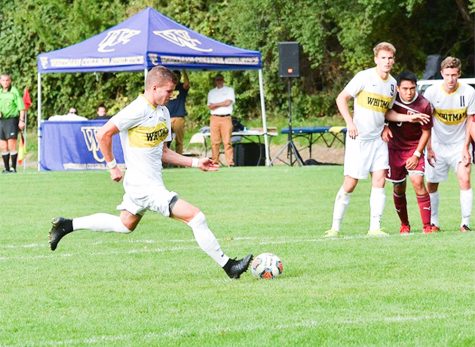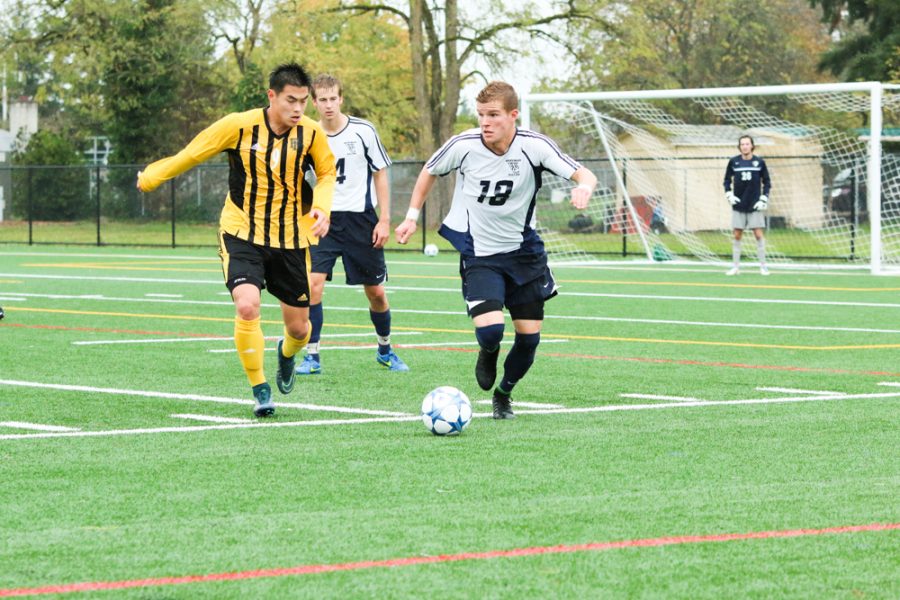The Long Road to Recovery: Injuries in Athletics
October 13, 2016
“Imagine working your whole life at your craft.Imagine winning [a] state [title], [a] championship, or maybe even experiencing that high [you feel] when you beat a rival team. Now, imagine not being able to feel [that high] as you watch your friends and teammates strive for greatness and surpass you. That’s what it’s like to tear an ACL,” senior soccer player Trayvon Foy said.
An athlete’s body is like a well-oiled machine. Treat it right with the best physical training, stretching routines, ice bath sessions and a little love and care, and that body will take you far. However, should you ignore its needs, that body will inevitably break down with no hope of full repair. Many veteran athletes often forget how much their bodies undergo throughout their athletic careers. They are taught to push our bodies to the absolute limit, becoming equipped with the skills to do so through the endless mile runs, dreaded leg days, and of course, pre-season plyos and sprints.
Though they have developed these tools to physically, mentally and emotionally take their bodies to their peaks, there comes a time in almost every athlete’s career when the body becomes exhausted, suggesting an obvious overload of physical demand. Unfortunately, it is almost inevitable that injuries can and will occur within any sport, regardless of level of strength, skill or coordination. The following are a series of athletes who underwent injuries while they were at Whitman. Now, each athlete has fully recovered or is in the process of doing so, steadily repairing all physical and mental damage little by little each day. Christian McDonald, Shae Kanakaole, Trayvon Foy, Cassidy Brewin and Noah Cavanaugh are amongst these athletes who have bravely undergone the road to recovery. In the interest of authenticity, each story is told as a first person account from the athletes’ perspectives..
Based on the stories of these athletes, it is clear that injuries are just another part of the game of athletics. All in all,while athletes may be debilitated at times, they push through and return to the court, field or gym as soon as possible. That is the beauty of being an athlete; resilience and relentless pursuit of their dreams.
Noah Cavanaugh

A junior on the Whitman men’s soccer team, Noah Cavanaugh experienced an abdominal injury that removed him from soccer for several months. Now a little over a month into the 2016 season, Noah is close to being fully recovered and recently returned to the field, scoring a goal in his debut game.
“In January of 2016 I suffered several tears to my abdominal wall during an exercise I’d been doing for 6 months for physical therapy,” Cavanaugh said.
“It was a low weight, low resistance type exercise, the last of which I would have expected to keep me out of soccer for almost 8 months. After a frustrating off season during which I tried multiple types of therapy, I was finally able to get an MRI in May which showed a large tear in my right side rectus abdominis, a tear in my right abductor, a tear in my left rectus abdominis, and a congenital hernia in my left side abdominal wall,” he added.
Despite this gnarly injury, Cavanaugh began to do everything in his power to begin the process of recovery, starting with surgery.
“Surgery was scheduled and done on July 19. I hadn’t worried about my psyche during the whole process, but in the weeks following the surgery, it was very challenging not to get caught in a downward spiral because I couldn’t play,” Cavanaugh said.
Like many athletes, Noah was emotionally affected by his injury, as it not only took away the game of soccer, but also took a toll on his self-image as a player.
“When [that] was taken away, I had to focus my energy on other things. I wouldn’t say it was a re-evaluation of who I was as a person, but I was used to spending several hours every day with a ball or in the gym [and]… something had to fill that hole.”
Noah’s surgery came just a few weeks before preseason, allowing him to become a vocal and positive role model for the new, younger players on the team.
Though Noah suffered a great deal of physical pain from this experience, he turned it into one of critical thinking and positivity, a task that many find very difficult.
In recent weeks, Noah has taken enormous steps in his recovery and was cleared to play 100% on October 4.
“I was successfully able to channel the frustration and anger I felt towards my injury into a very rigorous rehab schedule, and was able to come back earlier than the doctor’s expected because of my dedication [in recovering],” he said.
Noah is one of the millions of athletes that experience serious injuries such as this one, injuries that temporarily take away not only an athlete’s physical abilities, but part of who you are. As athletes our language is expressed through our hands, feet, bats and racquets. Take away our ability to manipulate those tools and we become voiceless.
Christian McDonald
Another fellow athlete who underwent a recurring injury was junior basketball playerChristian McDonald. As the 2016 season approaches, McDonald is currently recovering from a debilitating knee injury. During the 2015 season, McDonald tore his right meniscus for the second time and simultaneously suffered from a missing piece of knee cartilage.
“I tore my meniscus during a league playoff game against PLU and I thought our season was over,” McDonald said. Like many athletes in high impact sports such as basketball, Christian’s injury was extremely gruesome.
“I had to use crutches for six weeks because the micro-fracture surgery [I underwent] induces so much trauma within the knee that if I were to walk on it, it would be like walking on a broken bone,” he said. McDonald sat through the rest of the season, while graciously exhibiting a positive attitude and strong leadership with the rest of the team. The difficulties associated with the injury were not just physical.
“I’d say what affected me more than the recovery time, or the pain was the idea that I might have some genetic defect with my cartilage that would inhibit me from playing basketball, or even living an active life after basketball,” McDonald said.
Christian pointed to the support of his teammates throughout the recovery process as integral to his mental and physical health. McDonald is just another example of a Whitman athlete who has served as a great role model for those who have experienced similar injuries and recovery processes.
Shae Kanakaole
A third example of a stellar athlete who has ridden the road back to health is senior volleyball player Shae Kanakaole. During the 2015 season, Kanakaole sprained her ankle after landing on a teammate’s foot in the middle of a play. Instead of removing herself to focus on the recovery, Shae committed herself to the team.
“When I wasn’t able to play, I had to figure out how to help the other girls be better,” she said. “It changed my mentality in the sense that I had to figure out other ways I could contribute to the team since I was impaired physically. Shae was able to see the court shortly after her injury, but still learned from the ordeal that the response to the injury is more important than the physical toll.
Cassidy Brewin
Another athlete who is all too familiar with the world of pain is senior soccer player Cassidy Brewin. Brewin tore her labrum in her hip while preparing for her final year at Whitman.
I was playing in a game and as I was getting up after a dive to throw the ball to a teammate, I felt something in my hip give way and got a pretty bad shooting pain throughout it. It was so stupid because I completely did it to myself and it wasn’t the result of some badass tackle or save,” she said.
Brewin explained that the injury took her by surprise at the time that it happened and provided her with wave of disappointing news.
“Dealing with this definitely hasn’t been easy,” she added. “After I got an MRI to confirm the tear, I was told that since I’m a senior and this is my last season, I could play through the injury if I wanted to but I do have the chance of making my hip worse,” Brewin said.
This decision was difficult, and the stakes were high. One final season of soccer had to be weighed against possible arthritis or a future hip replacement.
“But in the end I realized that I really only have a few weeks left to play the sport that I love and I probably wouldn’t be able to get surgery until after season was over anyways so I might as well just play as hard as I can for these last few weeks,” she said.
Despite the difficult decision, Brewin continues to work hard and play her last few times on the pitch, an extremely admirable choice.






